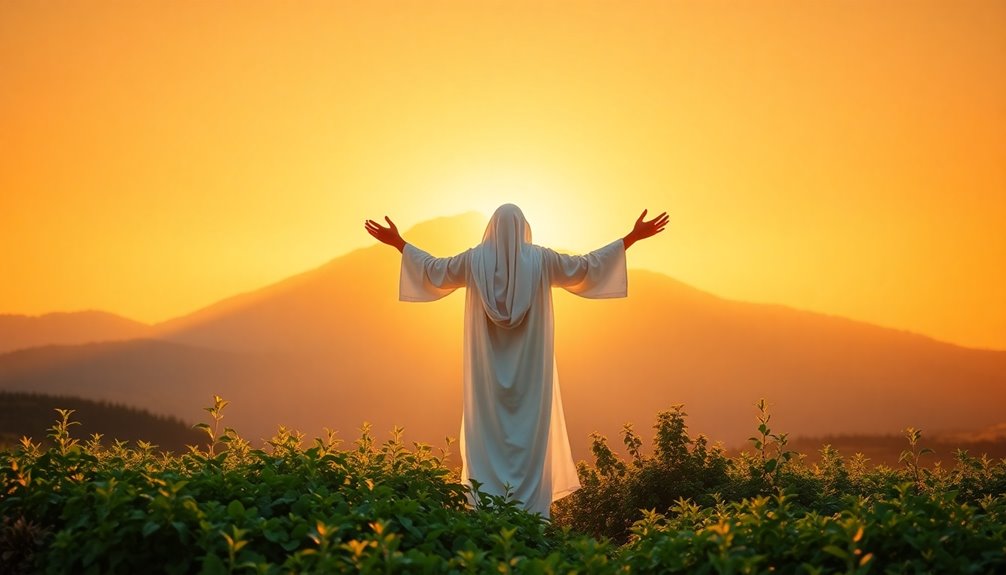Mary and Joseph were married shortly after their betrothal, which was considered a legally binding commitment in first-century Jewish culture. Their betrothal typically lasted about a year, emphasizing fidelity and societal expectations. During this time, they were regarded as married, even before the actual ceremony took place. Mary's unexpected pregnancy put Joseph in a difficult position, as he faced the dilemma of adhering to community norms. Ultimately, with divine guidance, he accepted Mary and their unique situation. If you're curious about the cultural context and significance surrounding their marriage, there's more to discover.
Key Takeaways
- Mary and Joseph were betrothed, which was considered a legally binding agreement, before their marriage was finalized.
- The betrothal period typically lasted about a year in first-century Jewish culture.
- Their marriage became official after Joseph was reassured by the angel regarding Mary's divine pregnancy.
- The marriage likely took place shortly after the Annunciation, when Mary received the news of her pregnancy.
- The consummation of their marriage followed after the wedding ceremony, confirming their marital status.
Introduction
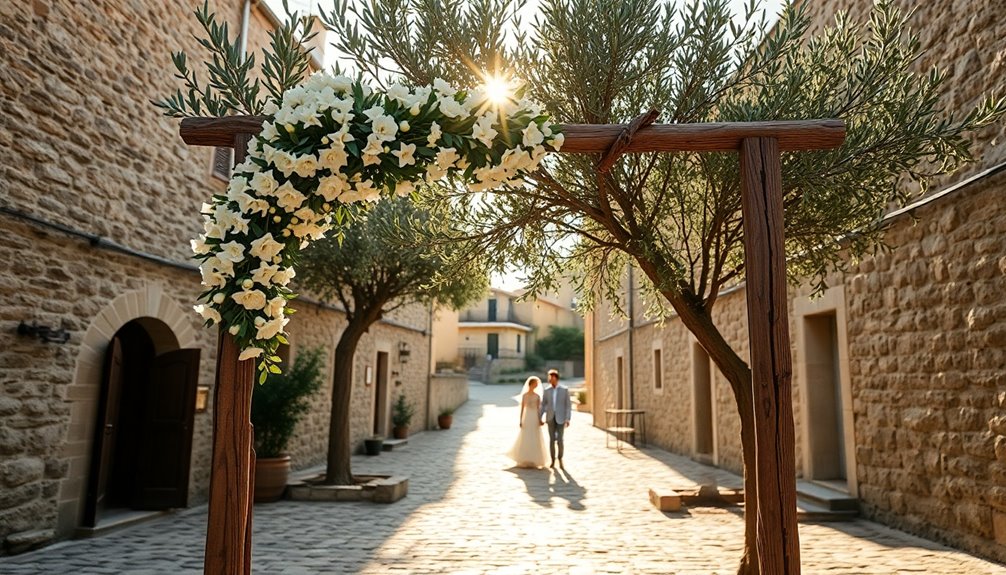
When you think about the marriage of Mary and Joseph, it's important to understand the cultural context of their time. In Jewish society, the concept of betrothal was a legally binding agreement, which meant that Mary and Joseph were considered married even before they'd physically consummated their relationship. This betrothal took place during the time of the Annunciation, when the angel revealed to Mary that she'd give birth to Jesus (Luke 1:26-38; Matthew 1:18).
Their betrothal was serious, and Joseph's initial decision to quietly divorce Mary upon learning of her pregnancy highlights the weight of societal expectations and the Jewish law surrounding perceived unfaithfulness (Matthew 1:19).
The couple faced significant challenges, but despite the circumstances, they ultimately married before Jesus' birth. This union fulfilled their cultural obligations, allowing them to navigate the complexities of their situation within their community.
Understanding this background helps you appreciate the depth of their relationship and the challenges they overcame as they prepared to welcome Jesus into the world.
Biblical Marriage Customs
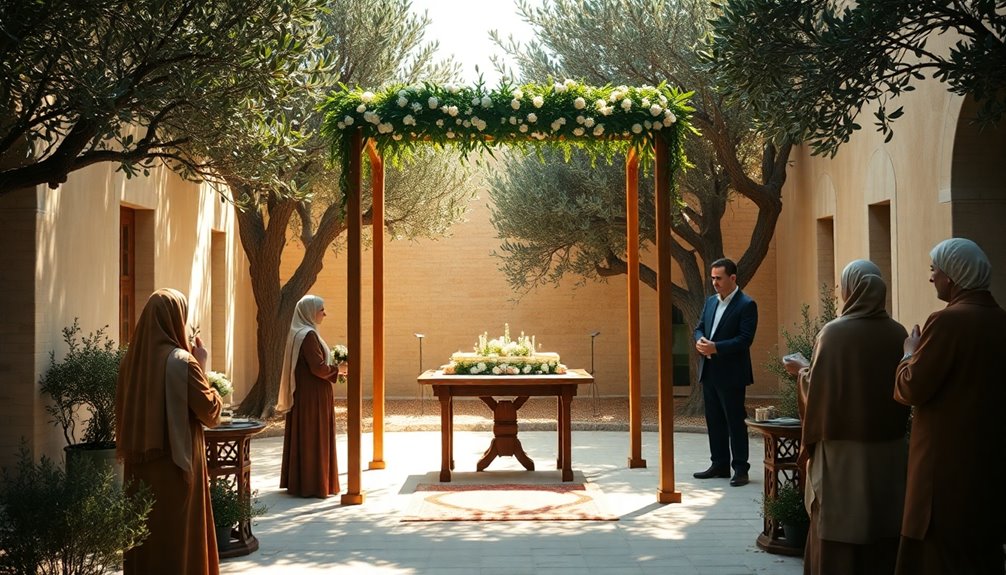
When you explore biblical marriage customs, you'll find that these traditions shaped the relationships of figures like Mary and Joseph.
From arranged marriages to the significance of betrothal, understanding these practices gives you insight into their lives.
Let's look at both primary and secondary Bible references to see how these customs were woven into their story.
Primary Bible References
While exploring the biblical marriage customs of Mary and Joseph, it's essential to understand that their betrothal was more than just an engagement; it was a legally binding agreement. According to Jewish law, during this period, they were considered married, even before the formal ceremony took place (Matthew 1:18). The betrothal typically lasted about a year, allowing them to prepare for their life together.
When Joseph learned of Mary's pregnancy, he faced a dilemma, as any perceived unfaithfulness could lead to divorce. His initial intention to separate quietly demonstrates his adherence to Jewish customs (Matthew 1:19).
However, everything changed when the angel of the Lord appeared to him, instructing him to take Mary as his wife, confirming their marital status despite not consummating their relationship before Jesus' birth (Matthew 1:24-25).
This context illustrates that Mary and Joseph were betrothed and regarded as married, signifying a serious commitment characterized by their faith and obedience to divine guidance.
Their story reflects the profound implications of love and trust in fulfilling God's plan through the Holy Spirit, leading to the miraculous birth of Jesus.
Secondary Bible References
Understanding secondary biblical references helps illuminate the customs surrounding marriage in ancient Jewish society. In this context, Mary and Joseph were betrothed, which meant their engagement wasn't just a promise but a legally binding contract, akin to marriage (Matthew 1:18).
During this betrothal period, lasting about a year, they prepared for their future together, though they weren't fully married until the marriage was consummated (Matthew 1:24-25).
Jewish law allowed for divorce even during betrothal, a serious commitment that Joseph considered upon learning of Mary's pregnancy (Matthew 1:19). This highlights the gravity of their engagement.
While the specifics of Mary and Joseph's wedding ceremony aren't detailed in the Gospels, it would have followed their betrothal and included a formal celebration, reflecting the customs of that time.
Scriptural references suggest that by the time of Jesus' birth, Mary and Joseph were considered married and living together, solidifying their marital status despite the absence of consummation before His arrival (Luke 2:5).
Their unique situation ties closely to the concept of the virgin birth, emphasizing the extraordinary nature of their marriage.
First-Century Jewish Customs
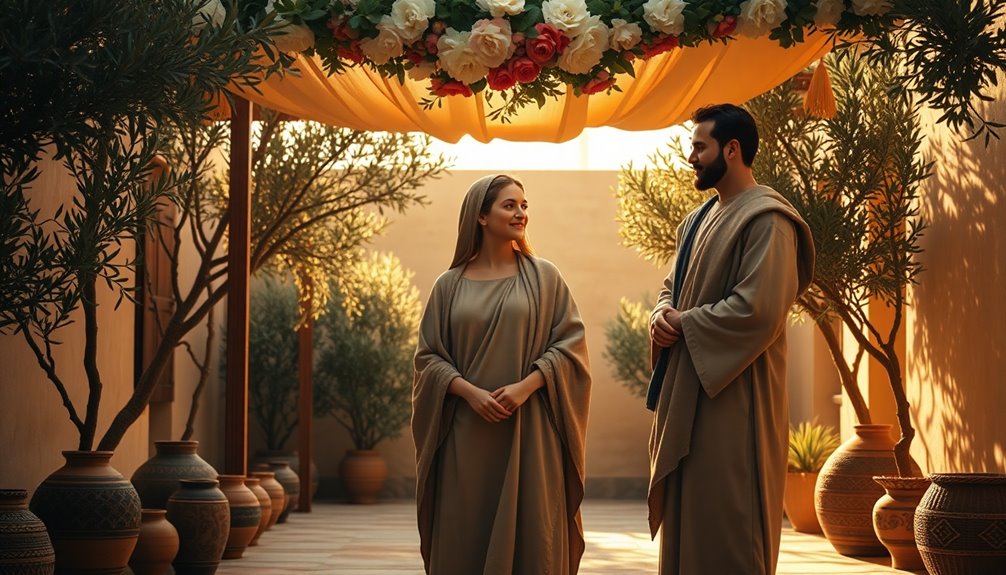
In first-century Jewish culture, marriage customs were deeply intertwined with family dynamics and societal expectations. Couples were typically considered legally married at the time of betrothal, even before the wedding ceremony.
This betrothal period, which usually lasted around a year, served as a test of fidelity. During this time, you'd be expected to remain celibate and have limited contact with your betrothed.
The engagement included a bride price, known as mohar, which the groom's family paid to the bride's family, highlighting the economic aspects of these unions. According to Jewish law, divorce was permissible during the betrothal period if unfaithfulness was suspected, underscoring the serious nature of the engagement.
Ultimately, the consummation of the marriage was necessary to finalize your marital status. The wedding ceremony marked the transition from betrothal to a fully recognized marriage.
This structured approach to marriage ensured that both families were involved, and the relationship adhered to the values and expectations of first-century society, laying a strong foundation for the couple's future together.
Cultural Significance of Betrothal
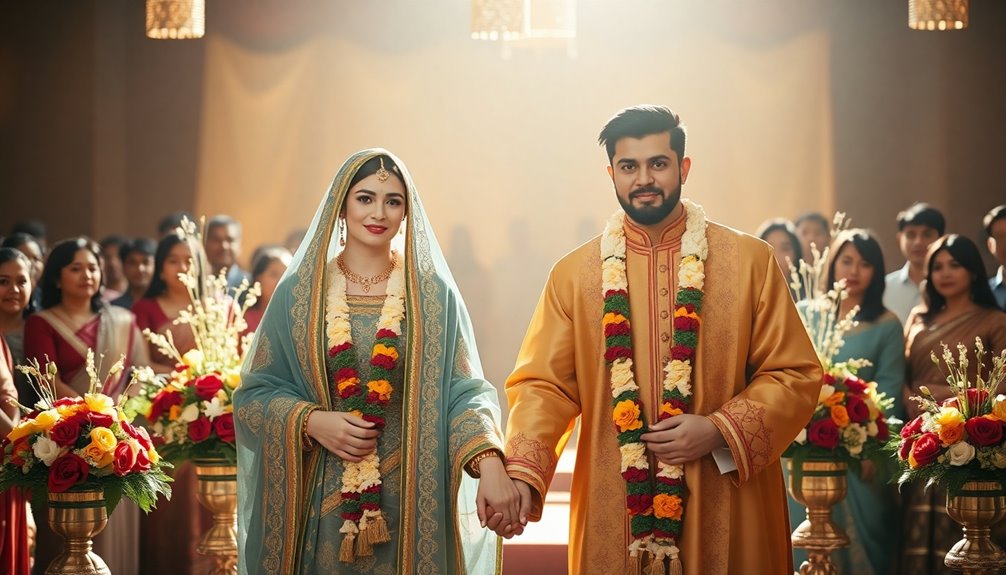
Betrothal held profound cultural significance in ancient Jewish society, shaping not just the relationship between Mary and Joseph but also their families and community. When they became betrothed, they were viewed as legally bound, similar to being married. This commitment was taken seriously, as the betrothal period, typically lasting about a year, allowed couples to prepare for their future together.
Jewish customs dictated that marriages were often arranged, reflecting societal norms where economic considerations played a significant role. The betrothal included a formal contract, making it a legally binding agreement that required a divorce to terminate. This underscores the seriousness of the commitment involved.
During this time, fidelity was paramount; any perceived unfaithfulness could lead to severe consequences under Jewish law. Joseph's initial reaction to Mary's pregnancy illustrates how deeply ingrained these values were in their culture.
The expectation of fidelity during betrothal not only impacted Mary and Joseph but also held weight in their community, reinforcing the importance of commitment and the sanctity of their union. Thus, their betrothal signified much more than just a promise—it was a reflection of their dedication to each other and their families.
Marriage Age in First-Century Palestine
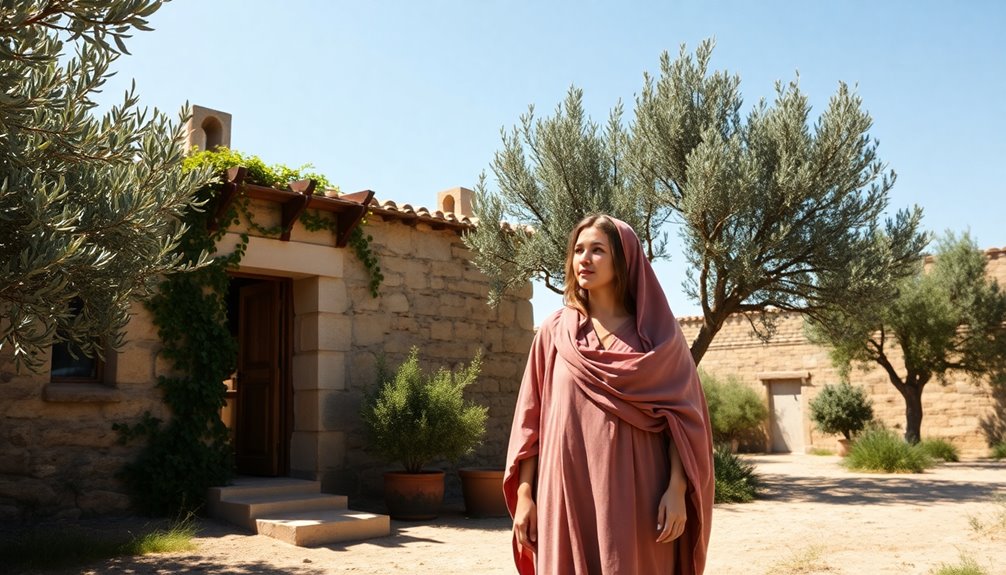
When you think about marriage age in first-century Palestine, it's essential to understand the norms of the time.
Contrary to some beliefs, girls often married as young as 14, while men were typically in their 20s or 30s.
This cultural backdrop shapes our understanding of Mary and Joseph's relationship and the societal pressures they faced.
Debunk Common Misconceptions
While many people might picture Mary and Joseph's marriage as a romantic union forged in adulthood, the reality of first-century Palestine paints a different picture. In this era, girls typically got married between the ages of 14 and 19, while men often were in their 20s or 30s. This age disparity leads to a common misconception that their relationship was more equal than it likely was. Joseph may have been considerably older than Mary, who was likely a young teen at their betrothal.
In Jewish custom, marriages were typically arranged by families, focusing on economic factors rather than personal affection. The betrothal process, which was legally binding, typically lasted about a year. During this time, Mary and Joseph prepared for their life together, navigating both societal expectations and familial obligations.
It's essential to understand that the engagement period was serious; it wasn't a casual relationship but a commitment reflecting the norms of their society.
Cultural Views on Marriage Age
In first-century Palestine, marriage age was dictated by cultural and societal norms that emphasized early unions, particularly for women. The ideal marriage age for young brides typically ranged from 14 to 19 years, while men often married in their 20s or 30s. This age disparity was common, reflecting the expectations of the time.
Families arranged marriages based on economic stability rather than romantic love, and the betrothal period served as a legally binding commitment, equivalent to marriage itself.
Cultural practices dictated that once a couple was betrothed, they were considered married in the eyes of society, even before the actual marriage ceremony took place. Societal expectations placed immense pressure on women to marry early and bear children, which influenced the timing of these unions in first-century Jewish culture.
As you explore Mary and Joseph's marriage, it's essential to understand these norms that shaped their lives. Their union not only reflected personal choices but also adhered to the broader cultural framework of their time, where familial arrangements and societal expectations played a crucial role in determining marriage age.
Marriage's Impact on Family Dynamics
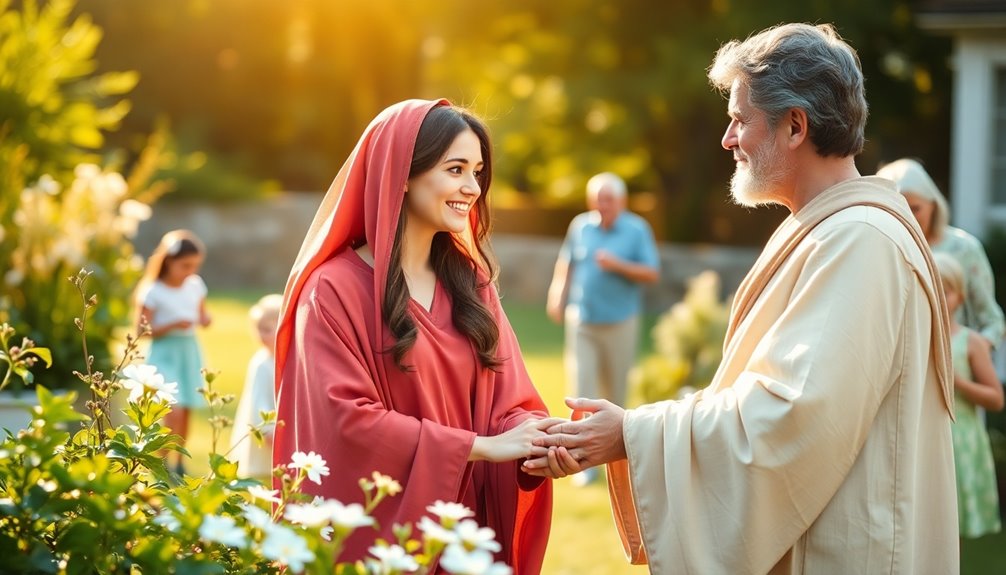
When you think about marriage today, consider how age and timing can shape family dynamics.
Just like Mary and Joseph's early union influenced their roles and responsibilities, your own choices can impact how you relate to one another and raise children.
Faith-based marriage workshops can offer insights into navigating these dynamics, drawing lessons from historical marriages like theirs.
Marriage Age Implications Today
Understanding marriage age and its implications can significantly shape family dynamics today. The cultural norms surrounding marriage age often dictate responsibilities within families. Historically, women typically married between 14-19, while men were often in their 20s or 30s. This early age of commitment influenced the dynamic, as individuals navigated familial alliances formed through arranged marriages, prioritizing family interests over personal choice.
The practice of betrothal, which was considered legally binding, meant that couples like Mary and Joseph were effectively viewed as married long before they lived together. This highlights the importance of commitment in shaping family structures and emotional bonds.
Today, we can observe how the historical context of early marriages informs discussions about family roles. Socioeconomic status also plays a crucial role in marital arrangements, affecting stability and overall family dynamics. For instance, the wealth and resources of a family can influence the responsibilities placed on younger family members.
Understanding these factors can help you navigate modern family dynamics, ensuring a nurturing environment for children while considering the implications of marriage age on relationships and future generations.
Faith-Based Marriage Workshops
Faith-based marriage workshops play a significant role in shaping family dynamics by providing couples with spiritual guidance and practical tools to strengthen their relationships.
These workshops emphasize the importance of aligning your marriage with faith values, fostering deeper communication and conflict resolution. By incorporating scriptural teachings, you learn to navigate challenges together, enhancing satisfaction in your relationship.
Moreover, these workshops address the impact of marriage on parenting. You'll discover how a solid marital foundation positively influences your children's emotional and social development, creating a nurturing environment for them to thrive.
Practical exercises focus on intimacy and mutual respect, essential elements in building a healthy family dynamic.
Couples who participate in these faith-based programs often report feeling more connected and satisfied in their marriages. As you engage in discussions and activities, you deepen your understanding of each other, reinforcing your commitment to one another.
Ultimately, faith-based marriage workshops equip you with the tools to cultivate a loving, supportive family atmosphere, where values and spiritual beliefs guide your journey together.
Embrace the opportunity to strengthen your relationship and positively impact your family dynamics.
Mary's Role in Jewish Society
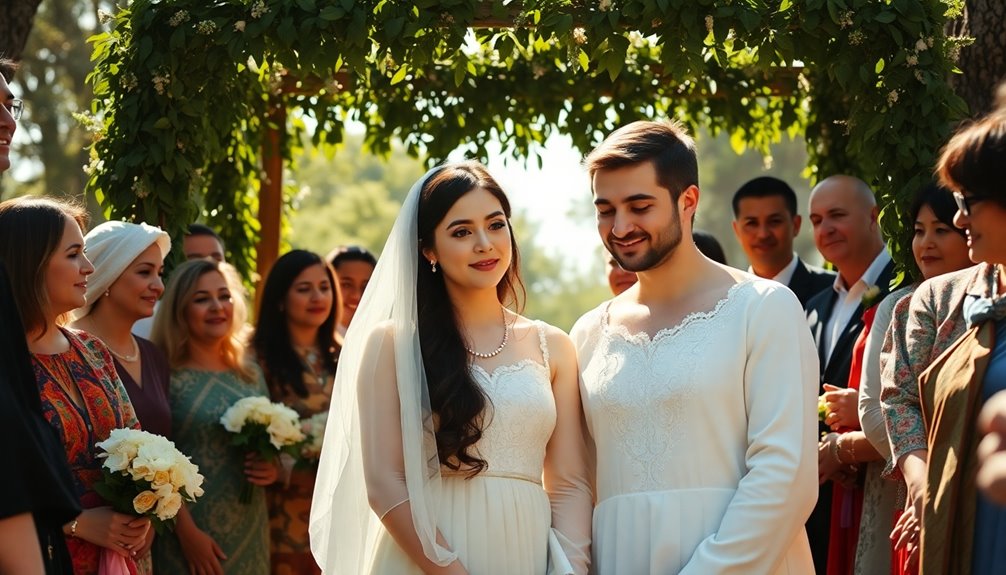
In ancient Jewish society, Mary's role was shaped by cultural norms and expectations surrounding marriage and family. As a young woman engaged to Joseph, she was legally betrothed to him, which meant their relationship was binding even if they hadn't yet consummated their marriage. This betrothal period served as a test of fidelity, with Mary's loyalty and commitment to Joseph being closely observed by their community.
Mary's engagement carried significant social and religious implications. In Jewish society, marriages were often arranged by parents, and women typically married in their mid-teens, while men were generally older. Thus, Mary's role as a betrothed woman emphasized her importance within the family and community. Her status not only reflected personal commitment but also highlighted the economic and social structures that governed relationships at the time.
Culturally, Mary's engagement would have positioned her as a key figure within her family, expected to uphold societal values and traditions. The implications of her betrothal to Joseph extended beyond personal ties, affecting their families and the larger community, illustrating the depth of Mary's role in Jewish society.
Additional Resources
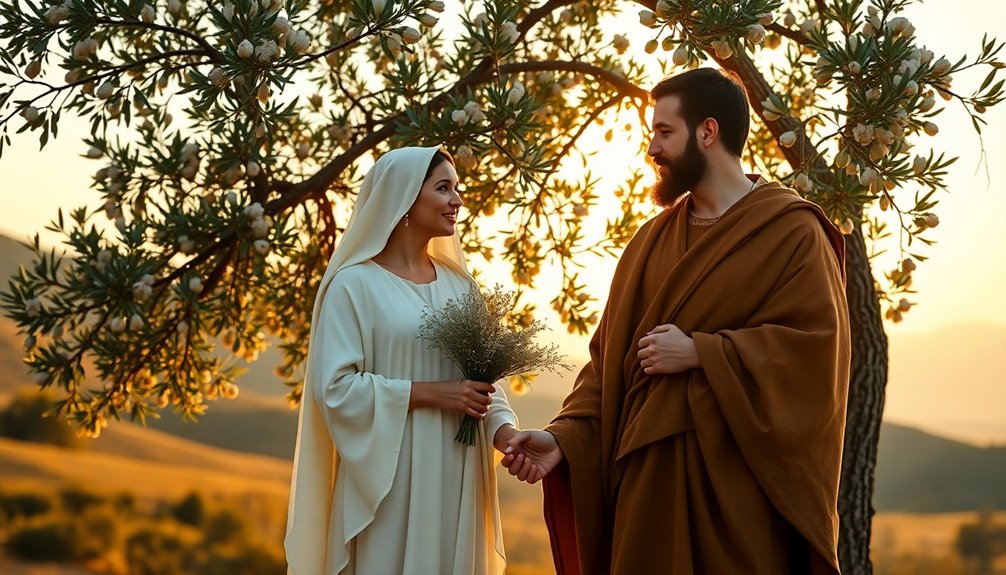
Explore a variety of resources to deepen your knowledge about Mary and Joseph's marriage within the context of ancient Jewish culture. Understanding their betrothal helps clarify the legal implications of their relationship. In ancient Jewish culture, being betrothed meant they were legally married, even before consummation. This context is crucial when considering the events surrounding the Annunciation.
You'll find it enlightening to examine biblical texts and historical commentaries that discuss Joseph's intention to quietly divorce Mary upon learning of her pregnancy. This highlights the seriousness of their betrothal and the legal obligations they faced.
Many resources detail how marriages were typically formalized after a year-long betrothal, showcasing the cultural practices of the time.
Look for scholarly articles or books focusing on Jewish marriage customs and the significance of divine instruction in Joseph's decision to take Mary as his wife after the Annunciation. These resources will provide insight into how their relationship evolved within the framework of their faith and traditions.
Frequently Asked Questions
Where in the Bible Did Mary and Joseph Get Married?
You won't find a specific passage in the Bible detailing the exact location of Mary and Joseph's marriage.
Instead, you learn from the Gospels that they were betrothed during the Annunciation in Luke 1:26-38. This betrothal was serious, akin to marriage, as noted in Matthew 1:18.
Joseph took Mary as his wife after divine guidance in Matthew 1:24-25, solidifying their marital status within the customs of their time.
How Many Children Did Mary Have After Jesus?
You'll find that the New Testament mentions Mary having at least four sons after Jesus: James, Joseph, Simon, and Judas, along with unnamed sisters.
However, interpretations vary widely. Some traditions argue these could be step-siblings or cousins, while others maintain that Mary remained a perpetual virgin, as emphasized in Catholic doctrine.
This disagreement highlights the theological debates surrounding Mary's motherhood and her role in the early Christian community.
At What Age Did Joseph Marry Asenath?
You might find it interesting that Joseph married Asenath around the age of 30.
This union came after he gained prominence in Egypt, following his successful interpretation of Pharaoh's dreams. Pharaoh gave Asenath, the daughter of Potiphera, to Joseph, showcasing the political alliances formed through marriage during that era.
Together, they'd two sons, Manasseh and Ephraim, who later played significant roles in Israel's history. Their story reflects the challenges and triumphs of their relationship.
Do Catholics Believe Joseph Was a Widower?
Yes, many Catholics believe Joseph was a widower before marrying Mary.
This belief stems from the Protoevangelium of James, which describes him as an elderly man with children from a previous marriage.
This portrayal emphasizes his protective role in the Holy Family, contrasting with the typical image of a young husband.
While the canonical Gospels don't confirm this, the idea of Joseph's widowhood highlights his significance in the narrative surrounding Jesus' conception and upbringing.






